ART IN CHANGING TIMES
Milenko Matanovic
Photo courtesy of Milenko Matanovic
Milenko is a community builder, artist and social innovator who has spent over three decades exploring the art of creative collaboration. He started the non-profit Pomegranate Center in 1986 after leaving a successful art career. His work has been exhibited internationally, including the 2017 Biennale of Venice.
As the founder of Pomegranate Center, he has worked with many neighborhoods around the country and abroad. Milenko has collaborated with numerous communities to build more than 60 gathering places. He helped develop community-owned plans for parks, town centers, streets, and trails, and trained hundreds of leaders in the Pomegranate Center method of community building. He teaches that, when it comes to society, together we always know more and that empowering communities is the most efficient, foundational way to improve society.
Milenko now writes (his newest book “The Case for Everyday Democracy” will be available in June 2019), trains and mentors new leaders, offers talks and consults with governments and non-profits on community, collaboration, and creative placemaking. Milenko has received numerous awards for his contributions.
All things deserve to be done well.
Whatever else art may mean to different people, at its core is the idea that human acts can be elegant in their expression, beautiful in form, resonant in relationship to people, materials, and community, and magical in their capacity to connect the part to the whole, whether that part is a brushstroke in a painting, a word in a poem, a piece of stone in a wall, a single note in a concert, a building in the city, a town in the landscape... Small, attentive steps combine to make an excellent whole.
In art, the process and end result are inseparable. Integrity in each step leads to good work.
Because it is simpler and less demanding to do this work in small doses rather than throughout our entire lives, we humans invented art to remind us how our lives should be. And soon afterwards, we started to forget that art is about everything and made it into something separate and special.
We pointed at something and called it art, and in that moment, without meaning to, we relegated the rest to not-art. What was originally meant to roam free, to be a part of everything, was now set apart.
Is it possible that when we accepted the notion of art’s exceptionality, we also unintentionally accepted that the world at large does not deserve our utmost care? Is this why we allow it to become polluted and ugly, violent and wasteful?
So, slowly, art has become a collective counterpoint to the madness of a modern world that glorifies planned obsolescence. The uglier our doings, the more we repent by putting up another art museum or pubic art project. (“Forgive me, Father, for I have sinned.” “Build a small museum and three public artworks. Do public art every year. Repeat the museum bit every twenty years. Your sins shall be forgiven.”) Museums will preserve valuable artifacts done with utmost care, but they will not replace what we destroy through our careless everyday activities.
High art will never – and shouldn’t – disappear. It must do its work to push boundaries, surf new waves, and teach us of new ways of being. We will rely on our most gifted poets and painters and musicians and film makers to open new awareness.
But high art can’t be the only art. In the future we must create communities and cities that are themselves works of art, rather than being satisfied with ugly, wasteful communities with token artworks to absolve us from the greater task of creating a truly vibrant and sustainable culture. In this future, artistic quality will be expected of everyone and deposited, with care, into more and more things until everything is art. Excellence will be everywhere.
If this vision is true, then there is a great new opportunity for artists: to loan their talent and expertise to planners and architects and merchants and politicians and environmentalists. Artists can serve the emergence of a new culture in a whole new way.
This was my journey. After a short career as an avant-garde artist in Slovenia (former Yugoslavia), I left the high-art world to see how my skills as an artist could benefit communities. I created a non-profit organization to push art into life and utilize creativity for societal problem solving. I’ve worked with local, state and federal agencies, developers and many non-profits and community groups.
This path is wide open to other artists. All we need to do is agree to serve and use our creative ego to continuously and courageously listen to people and nature, and explore good questions, like: how would an artist build a neighborhood? A street? A park? A school? A city? A building? A society? And then be ready to collaborate with others in making the world the recipient of our gifts.
What an exciting time to be an artist!
Photo courtesy of Milenko Matanovic
Alberta Gathering Place, Tuscaloosa, Alabama, 2012
Materials: debris from the devastation left behind from the 4.27.2011 tornado: fallen trees, salvaged metal, broken concrete sidewalks, shade banners.
Built in nine days with many volunteers guided by the Pomegranate Center team: architect/builder Duncan Chalmers, project leader Bree Dillon, volunteer coordinator Hannah Hidaka, and art director Milenko Matanovic.
This project was funded by the Tully brand of the Green Mountain Coffee Rosters in Vermont.
Photo courtesy of Milenko Matanovic




